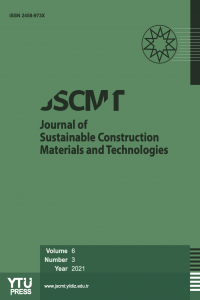Assessment of long time approximation equation to determine thermal conductivity of high porous materials with NSS probe
Assessment of long time approximation equation to determine thermal conductivity of high porous materials with NSS probe
___
- Al-Homoud M, Performance characteristics and practical applications of common building thermal insulation materials, Building and Environment, Vol. 40 (3), pp. 353-366, 2005.
- Hooper FC, Lepper FR, Transient heat flow apparatus for the determination of thermal conductivities, Transactions American Society of Heating and Ventilation Engineers, Vol .56, pp. 309-324, 1950.
- Joy FA, Thermal conductivity of insulation containing moisture, ASTM Symposium on Thermal Conductivity Measurements, pp. 65-80, 1957.
- Batty WJ, O'Callaghan PW, Probert SO, Assessment of the thermal-probe technique for rapid, accurate measurements of effective thermal conductivities, Applied Energy, Vol.16, pp. 83-113, 1984.
- Hust, JG, Smith, OR, lnterlaboratory comparison of two types of line-source thermal-conductivity apparatus measuring five insulating materials, National Institute of Standards and Technology, Report N. 89/3908, for U.S Dept. of Energy, Oak Ridge National Laboratory, 1989.
- Pilkington B, In situ measurements of building materials using a thermal probe, phD, University of Plymouth, England, 2008
- Carslaw HS, Jaeger JC, Conduction of Heat in Solids, 2nd Ed., Oxford University, London, 1959.
- Abramowitz M, Stegun I, Handbook of Mathematical Functions with Formulas, Graphs and Mathematical Tables, Chapter 5, 9th Dover Printing, 10th GPO Printing Ed., Dover, 1964.
- Achard G., Roux J.J, Sublet, J.C “Description d’une sonde de mesure des caractéristiques thermiques des couches superficielles du sol. Résultats d’une campagne de mesures”, Revue Générale de Thermique, N° 267, pp 177-188, 1984.
- Vos B, Analysis of thermal-probe measurements using an iterative method to give sample conductivity and diffusivity data, Appl. Sci. Res., pp. 425–438, 1955.
- ASTM D 5334 – 08, Standard Test Method for Determination of Thermal Conductivity of Soil and Soft Rock by Thermal Needle Probe Procedure, Approved 2008.
- Blackwell JH, A transient-flow method for determination of thermal constants of insulating materials in bulk, Part 1-Theory, Journal of Applied Physics, Vol. 25, N. 2, pp.137-144, 1954.
- Humaish H, Ruet B, Marmoret L , Beji H, Thermal characterization of highly porous materials by the hot wire method, in proceeding of the French Thermal Society (SFT) congress, La Rochelle, France, 2015.
- Ruet B, Humaish H, Marmoret L, Beji H, Assessment of thermal probe technique for determination of effective conductivity of building insulation materials, in proceeding of the 20 th European Conference on Thermophysical Properties (ECTP), Porto, Portugal, 2014.
- Testu A., “Caractérisation thermique dans les milieux granulaires, caractérisation à cœur et en proche paroi”, phD of Lorraine Polytechnic National Institute, France, 2005.
- Huetter ES, Koemle NI, Kargl G, Kaufmann E, Determination of the effective thermal conductivity of granular materials under varying pressure condition, Journal of Geophysical Research, Vol.113, ref. E 12004, 2008.
- Achchaq F, Etude hygrothermique de matériaux isolants fibreux (in French), PhD Picardie Jules Verne University, 2008.
- Hakansson B, Andersson P, Backstrom G, Improved hot-wire procedure for thermophysical measurements under pressure, Review of Scientific Instruments, Vol.59, n°10, pp.2269-2275, 1988.
- Pilkington B, Grove S, Thermal conductivity probe length to radius ratio problem when measuring building insulation materials, Const. and Build. Materials, Vol.35, pp 531–546, 2012.
- Murakami, EG, Sweat VE, Sastry SK, Kolbe E, Datta A, Recommended design parameters for thermal conductivity probes for non-frozen food materials, Journal of Food Engineering, Vol. 27, pp. 109-123, 1996.
- Van der Held EFM, The contribution of radiation to the conduction of heat, Applied Scientific Research, Section A, Vol. 3, pp 237-249, 1952.
- Van der Held EFM, The contribution of radiation to the conduction of heat: boundary conditions, Applied Scientific Research, Section A, Vol. 4, pp 77-99, 1953.
- Woodside W, Calculation of the thermal conductivity of porous media, Canadian Journal of Physics, Vol. 36, pp. 815-823, 1958.
- Eschner A, Grosskopf B, Jeschke P, Experiences with the hot-wire method for the measurement of thermal conductivity of refractories, Vol. 98, N.9, (in German) - cited in Davis WR, Downs A, The hot wire test- a critical review and comparison with the BS 1902 panel test, Transactions British Ceramic Society, Vol. 79, pp.44-52, 1974.
- Coquard R, Baillis D, Quenard D, Experimental and theoretical study of the hot-wire method applied to low-density thermal insulators, International Journal of Heat and Mass Transfer, Vol. 49, pp. 4511– 4524, 2006.
- Laurent JP, Contribution à la caractérisation thermique des milieux poreux granulaires (in French), phD of Grenoble Polytechnic National Institute, France, 1986.
- Başlangıç: 2016
- Yayıncı: Yıldız Teknik Üniversitesi
Modeling of Damage Evolution and Fracture in 5182 H111 Aluminum Alloy
El Amri ABDELOUAHİD, Mounir El Yakhloufi HADDOU, El Khamlichi ABDELATİF
Hussein HUMAİSH, Bastien RUET, Laurent MARMORET, Hassen BEJİ
LISI – the House - Living Inspired by Sustainable Innovation
Cleanliness of ventilation ducts, indoor space and AHU
Aleš RUBİNA, Olga RUBİNOVÁ, Petr BLASİNSKİ
Dust analyses in ventilation ducts
Karolina Vyhlidalova, Petr VLČEK, Olga RUBİNOVÁ, Jiří BERNARD
